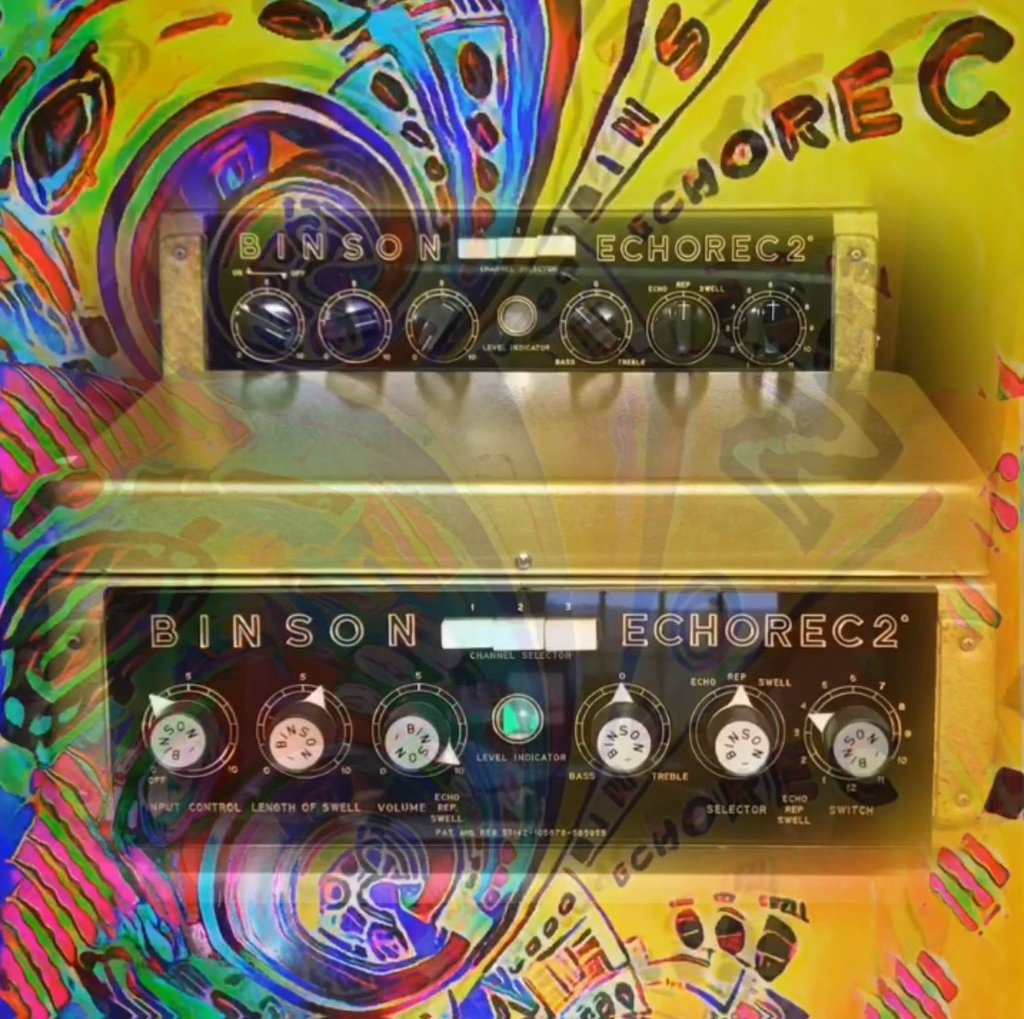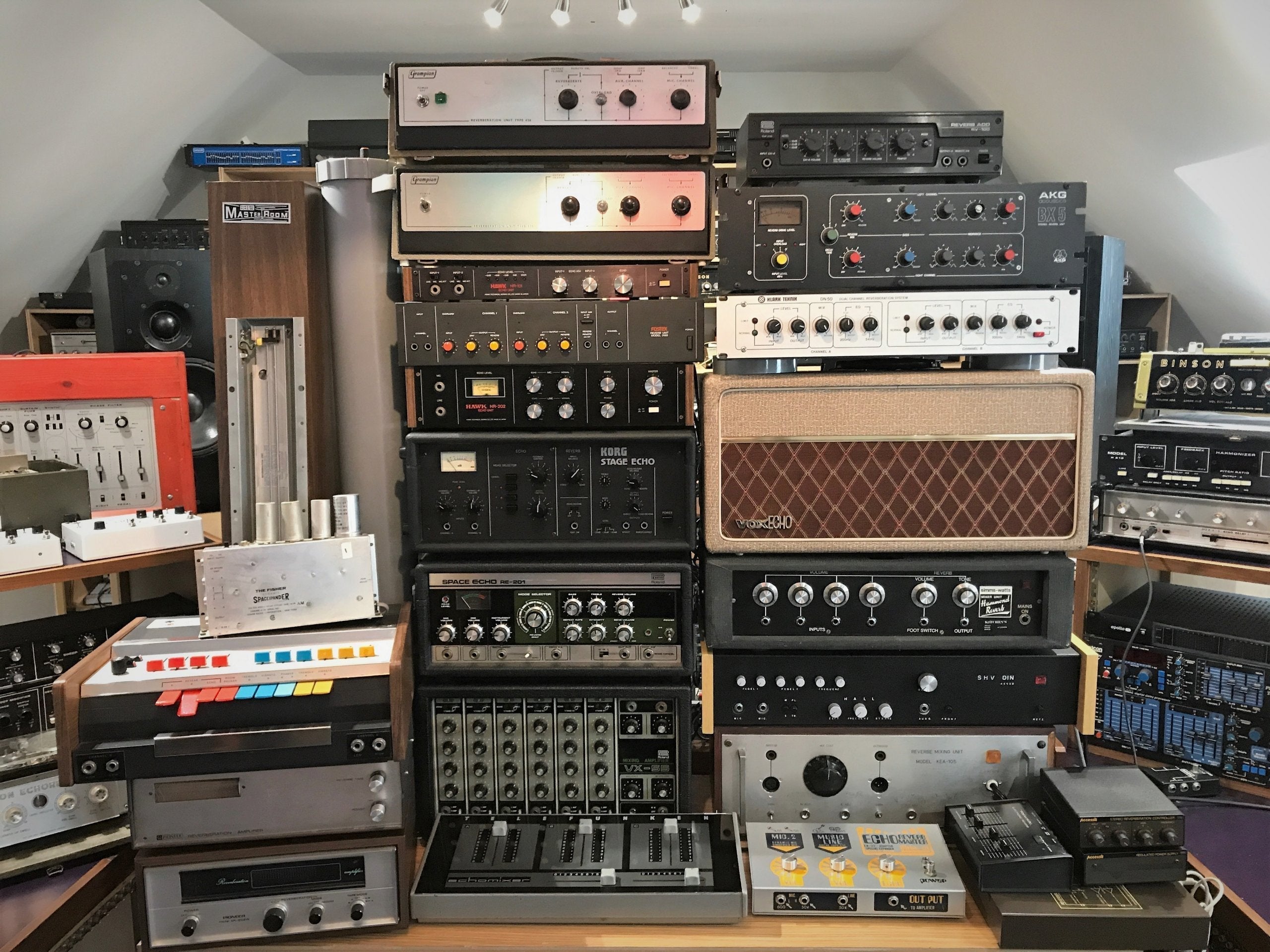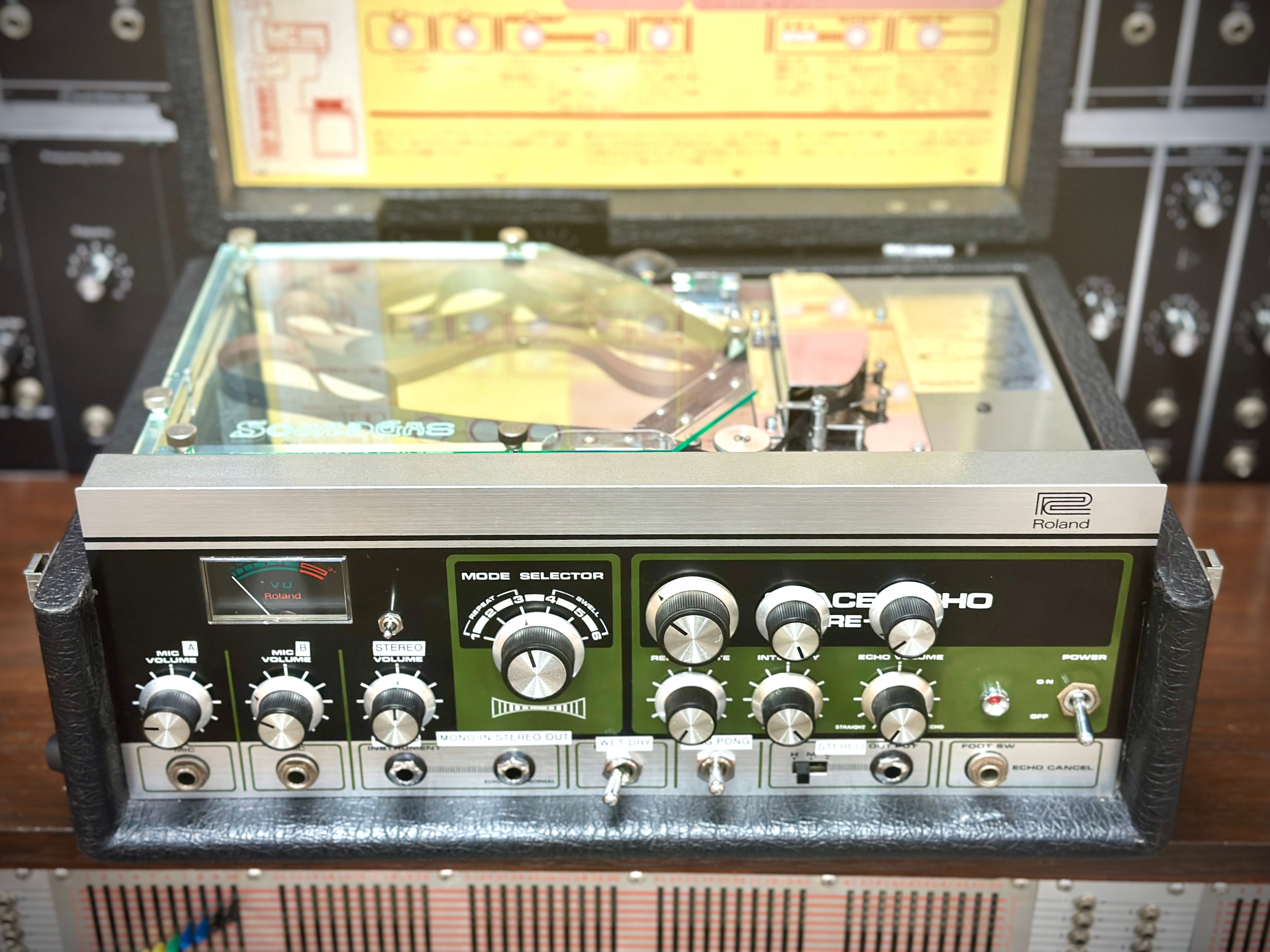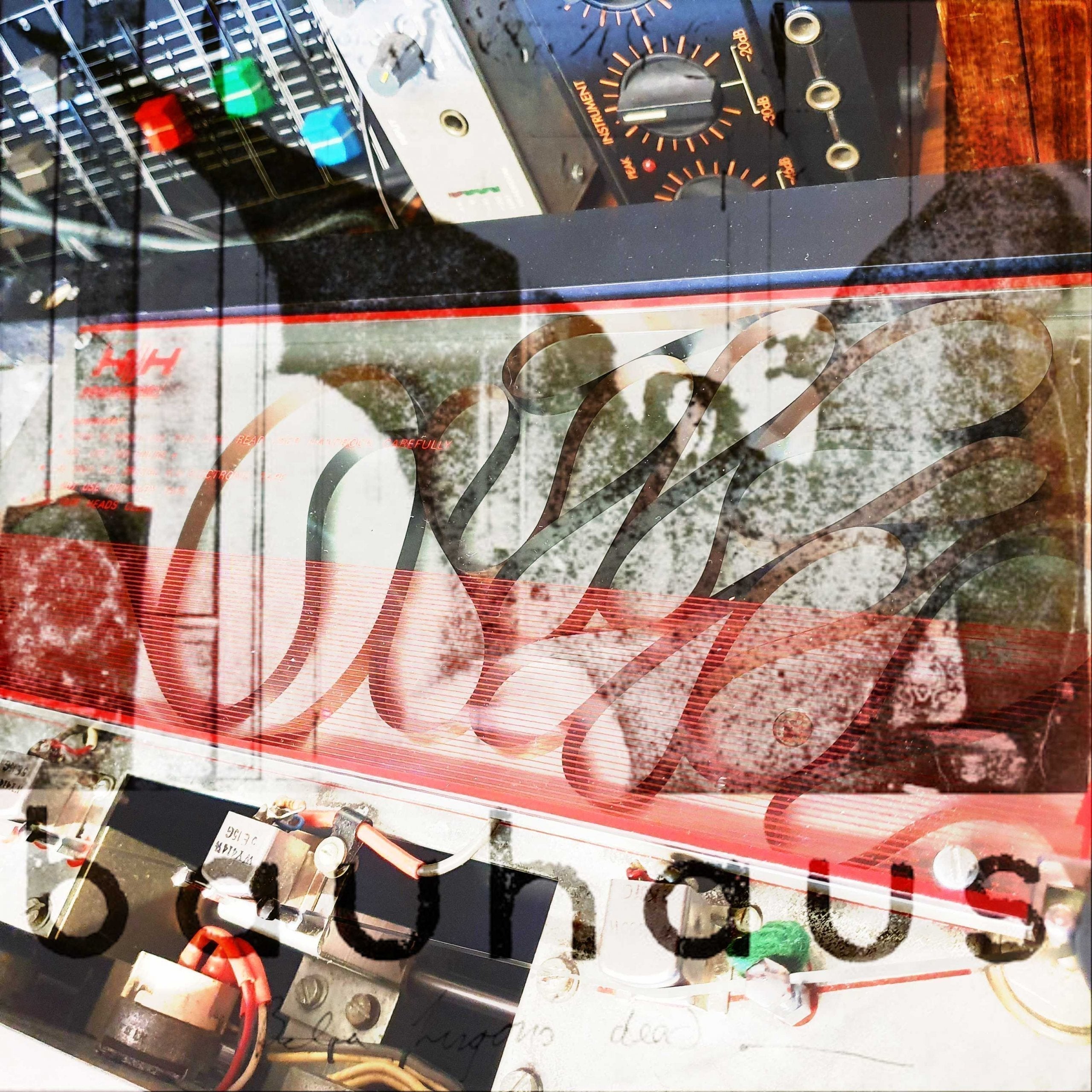
Binson Echorec Varispeed Modification
Guide to Binson Echorec Varispeed Modifications
We now offer varispeed modification on most of the Binson Echorecs we we sell. But, if a standard Echorec was considered adequate for Barrett, Gilmour, and Page, why would you modify a vintage Echorec with a variable speed motor? This article covers some of the "why" and also takes a look at the "how" of augmenting vintage Binsons... Binson Echorecs were all manufactured with a fixed speed motor and Binson founder, Dr Bonfiglio Bini, together with his principal engineer, Scarano Gaetano, created something very special with their considerations for the fixed head spacings of the Binson Echorec. The four playback heads on an Echorec 2 offer delay times of approximately 75ms, 150ms, 225ms, and 300ms. Dr Bini chose these spacings to create musically-related delay times: if the longest delay tap is a quarter note, then head three is a dotted eighth note, head two is an eight note, and the first head a sixteenth note. The shorter repeats are perfect for classic slapback delays, as heard on countless rock’n’roll and rockabilly records (and much beloved of John Lennon for his vocal sound). U2’s The Edge created his signature sound using patterns akin to the longer two heads on the Echorec 2. The longer rhythmic delay intervals are extremely inspiring and can be heard on many classic Pink Floyd recordings from the early days with Syd Barrett, through to Dark Side Of The Moon and beyond. Pete Townshend told me how he’d wanted an Echorec ever since he saw Syd play with the Floyd at the UFO Club in 1967. According to Pete, Syd played one chord into two Echorecs and the band jammed along for half an hour to the resulting oscillations... Here's how a good Echorec T7E should sound:Watching Pink Floyd Live At Pompeii, you witness Echorecs employed by David Gilmour on guitar, Roger Waters on bass (‘One Of These Days’ owes it’s opening bass riff to the Echorec) and Richard Wright on keyboards. Indeed this film is essential viewing for anyone asking themselves why they want to buy a vintage Binson Echorec. Many of Gilmour’s guitar parts, and Pink Floyd’s songs rely heavily on the rhythms created by the fixed-head repeats of their Binson Echorecs. This caused some trouble when, on arriving in the USA to tour, they found running European Binsons at a US mains frequency of 60hz resulted in significantly-shorter delay times and thus faster tempos. Phil Taylor (David Gilmour and Pink Floyd’s long-serving guitar tech and curator of Floyd gear) told me how he had to stay up all night after the first rehearsal modifying the head spacings on all their Binsons so they’d play at the correct tempo for the American tour! Echorecs manufactured for the US export market (under the Guild name) had motors with smaller diameter spindles which altered gearing ratio to retain the signature Binson tempo. A European Binson will play around 20% faster in the USA, and a US export machine about 20% slower in Europe. It’s not just guitarists who found inspiration in those distinctive Binson Echorec echoes: Jimmy Page employed one on John Bonham’s drum kit when recording Led Zeppelin IV at Headley Grange. While that now-legendary stairwell played a big part in the epic drum sound on ‘When The Levee Breaks’, it was a Binson’s repeats that inspired and contributed to Bonzo’s famous rhythm.View this post on Instagram
Why Modify A Binson Echorec With Varispeed?
If a standard Echorec was considered adequate for Syd Barrett, David Gilmour, Pink Floyd, Jimmy Page and Led Zeppelin, why would you wish to modify a vintage Echorec with a variable speed motor? While in the fifties, sixties and seventies, it was quite normal for an echo to have a fixed repeat rate, today’s musicians are used to being able to ‘tune’ their delay repeats to the song tempo. Indeed a variable speed motor opens up the potential of these machines - enabling them to lend their distinctive sound to songs played at a wider range of tempos. Put simply, it widens the scope of what’s possible from a Binson Echorec, and with the significant cost of buying a well-restored example, it makes sense to not be limited by a fixed speed motor. Below are a couple of our demos with modified machines. Scroll to the bottom of this article for more.How Do You Varispeed A Binson Echorec?
I've been researching varispeeding Echorecs for almost as long as I’ve had one of my own. The late, great, Eric Snowball of ESE Music used to use a (now unavailable) Trident motor for his varispeed conversions, but at the time I couldn’t afford that option. I've worked with several Binson engineers over the years, a couple of whom had their own solutions, but who were not prepared to share that knowledge further. One simple solution is if you own a machine with a DC motor - many of the later solid state models had these fitted as standard. These motors can be fitted with a variable speed control with very minimal additional work and run very well. However, it’s the classic valve machines which are of the most interest to many people and these are fitted with AC motors: varispeed conversion requires the fitting of a new motor and varispeed control. This is a not-inconsiderable operation and many factors have to be taken into account when designing an appropriate solution, for example torque, motor noise, size and reliability. Some engineers’ solutions involve modifying the Echorec chassis to fit a new motor - our standard varispeed option uses a motor that requires some chassis modification. Some time ago, I asked our in-house echo guru, Dr Huw, to investigate the definitive Binson varispeed solution. We knew we wanted a reliable and stable motor that did not require any modification to the chassis of the Echorec, and that it needed to run reasonably-quietly as well as performing well at very low speeds. After a great deal of experimentation and much time spent trying and discarding various potential motors, Dr Huw came to me with what is now our Super-Slow Binson Varispeed Motor. This motor runs stably down to a virtual standstill. Naturally at greatly-reduced speeds, the bias changes to the point of significant loss of fidelity and ability to oscillate. In other words, it gets properly gnarly when pushed into distortion at slow speed and should be viewed as being for experimental sound design rather than extremely laid-back Shadows covers. This is precisely why I pushed for a super-slow motor: regular users don’t need to venture that low down the dial - it offers the full functionality of a standard varispeed - but has the added appeal of the super-slow speeds for longer, darker, dirtier repeats. At seriously slow speeds, you get to hear the individual nuances of each head and preamp - heads that appear very well-matched at regular speeds reveal their character at the low speeds - on some machines this can result in strange metallic resonances. Anything that adds an extra flavour option into the mix. So if you’re a guitarist wanting to use your Binson Echorec in the more traditional manner, you may find our regular varispeed serves you perfectly well, but if you occasionally veer off onto darker, stranger musical paths, maybe the Super-Slow option makes more sense for you. And if you’re into sound design, electronic or experimental music, then it’s a no-brainer: pair it with our wet-only output modification and marvel at the dark sound of a wire-wrapped drum passing the heads ponderously. If you want to know more or discuss which machine is best for your needs then get in touch. See some of our Echorecs for sale here, however many of our Binson machines are serviced and modified to order - contact us to find out what we have in the Doctor's waiting room now. More Super-Slow demos below. For more background and information - check out our other Binson Echorec Resources. ========== Tony Miln is the co-founder (& Head Gear Head) of Soundgas. See/hear him in action on Instagram.View this post on InstagramProper weird and wonky beats with the MPC-1 and a gnarly super-slow varispeed Binson Echorec 2.
Previous post
Regeneration: Synths Beyond Sustainability
Next post







